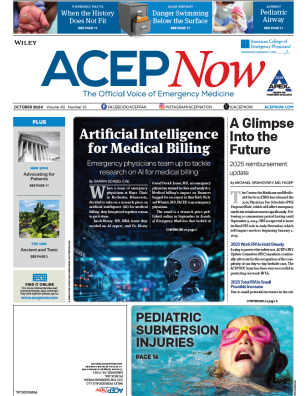
WASHINGTON, D.C.—Most sore throats are minor in nature and physicians often refer them to fast track or even try to take care of them quickly, according to Tracy G. Sanson, MD, FACEP, associate professor of emergency medicine at the University of Central Florida College of Medicine in Orlando and Team Health’s division of medical leadership education and professional liaison. However, there are several presentations that merit rapid identification and intervention because of their potential severity.
Explore This Issue
ACEP17 Tuesday Daily NewsIllnesses such as diphtheria and botulism are on the rise. Patients appear toxic, are lethargic, and, more ominously, whisper rather than talk. In diphtheria, a gray membrane covers the tonsils and throat. Both require the appropriate antitoxin for definitive treatment.
Threats to airway patency, such as Ludwig’s angina and epiglottitis, may require nasal or oral intubation in the awake patient. Dr. Sanson offers a few tips in preparing the airway, including coating the laryngoscope with viscous lidocaine, nebulizing lidocaine, or combining lidocaine with Neo-Synephrine and spraying it in the nare. Follow the lidocaine with a size 32 nasal trumpet, allowing it to stay in place while vasoconstriction and anesthesia takes place.
Accidentally puncturing the carotid artery while draining peritonsillar abscesses can be avoided by cutting off part of the needle guard of the syringe so that only enough of the needle is exposed to puncture the tissue at the correct depth. Alternatively, insert the needle through the center of a blood tube cap to limit the length of the needle. A spinal needle can also be used, and has the advantage of keeping the fingers outside of the mouth. If an incision is warranted, wrapping the blade with tape and exposing only the length necessary to lance an abscess provides a safeguard.
During these procedures, allowing patients to handle their own suction catheter can be more effective in minimizing secretions going down the throat and keeps the physician’s hands available. The patient can also hold a laryngoscope or LED speculum to provide illumination during the procedure, and keep the tongue out of the way.
Dr. Sanson suggests getting comfortable with ultrasound, as it can be a key tool in differentiating an abscess from early cellulitis. Performing the ultrasound at bedside may help avoid a costly trip to the CT room.
Managing post tonsillectomy hemorrhage can be challenging. Sometimes the often-used techniques of direct pressure, epinephrine/lidocaine injection, or tea bag placement do not work. Soaking a pledget with tranexamic acid (TXA) may be useful in these situations. Alternatively, crush two TXA tablets with a couple of milliliters of fluid to create a paste and insert the paste into the socket. This technique has the added benefit of being significantly less expensive.
Pages: 1 2 | Single Page




No Responses to “Quick Tips for ENT Emergencies”